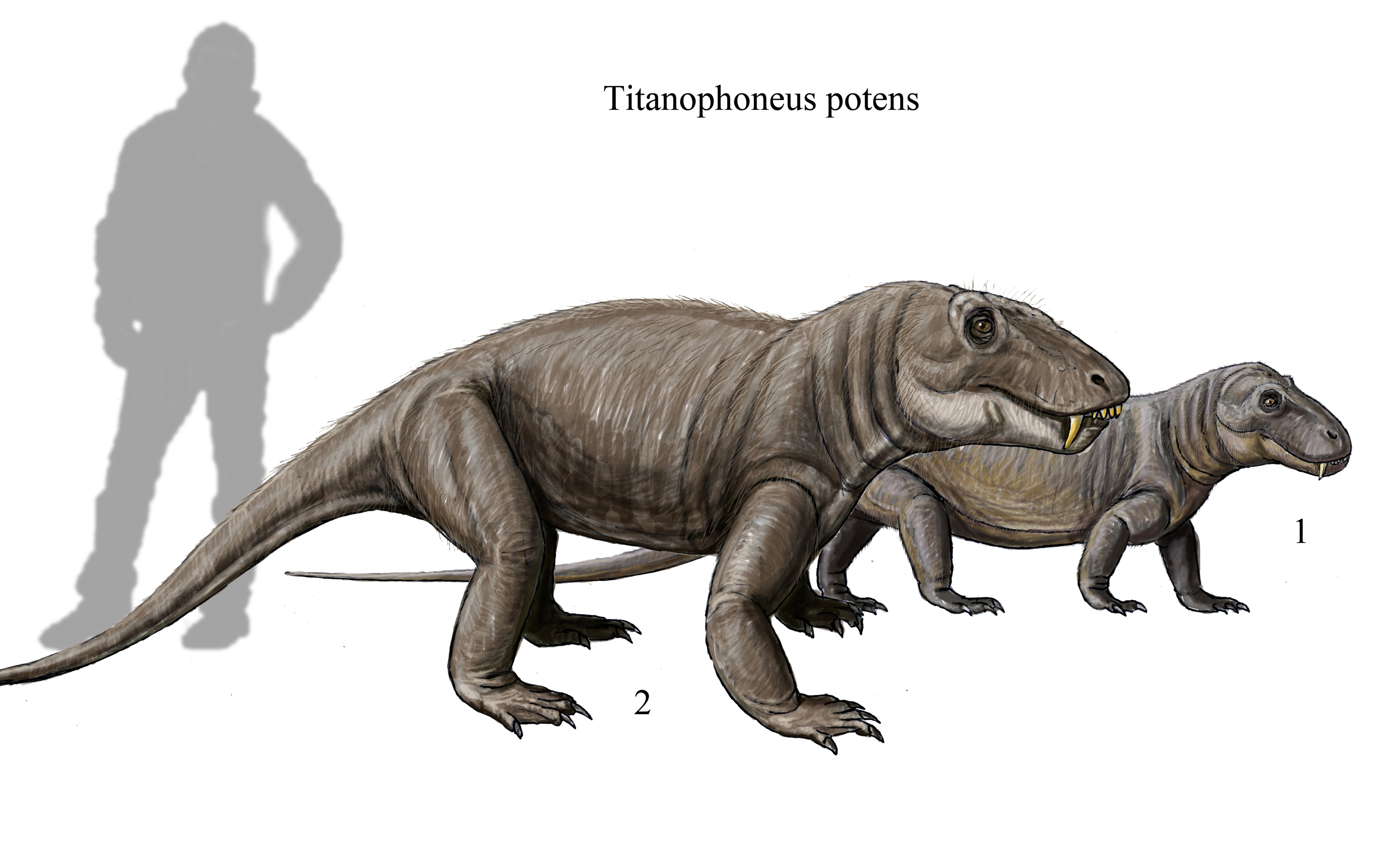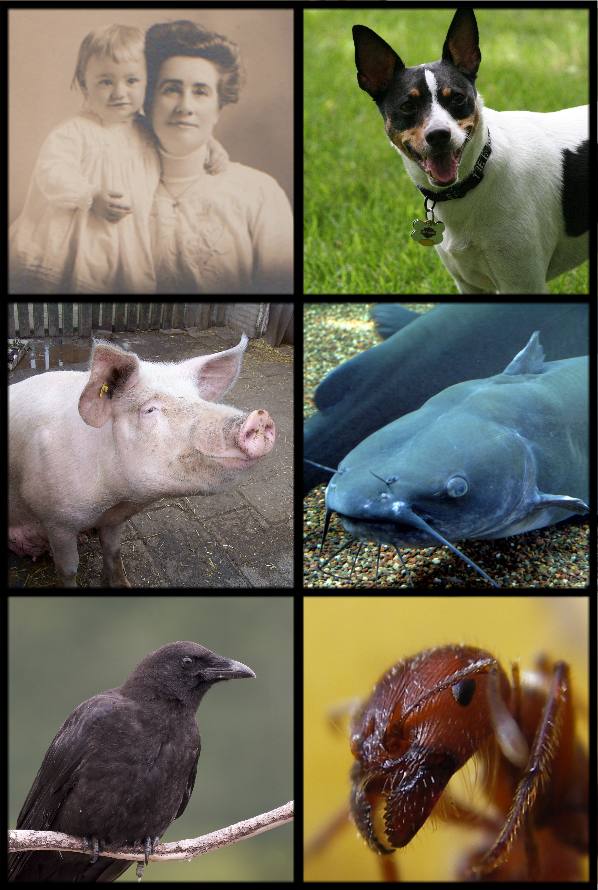|
Titanosuchidae
Titanosuchidae is an extinct family of dinocephalians known only from the middle Permian ''Tapinocephalus'' Assemblage Zone of South Africa. The titanosuchids were large, omnivorous or herbivorous animals. As with other tapinocephalians, they had thickened skulls that may have been used in head-butting, but to a lesser degree than in Tapinocephalidae or Anteosauridae Anteosauridae is an extinct family of large carnivorous dinocephalian therapsids that are known from the Middle Permian of Asia, Africa, and South America.These animals were by far the largest predators of the Permian period, with skulls reachin .... They had large canine teeth, strong incisors with a "talon and heel" morphology, and leaf-shaped postcanine teeth. Two titanosuchid genera are recognized as valid: '' Jonkeria'' and '' Titanosuchus''; they can be distinguished on the basis of limb proportions. References External linksTitanosuchidae at Kheper website. Tapinocephalia Guadalupian first appeara ... [...More Info...] [...Related Items...] OR: [Wikipedia] [Google] [Baidu] |
Tapinocephalia
The Tapinocephalia are one of the major groups of dinocephalian therapsids and the major herbivorous group. Tapinocephalia has been found to consist of three clades: Styracocephalidae, Titanosuchidae, and the very successful Tapinocephalidae. Notable tapinocephalians include ''Moschops'', ''Tapinocephalus'', and '' Titanosuchus''. Description Unlike anteosaurs and estemmenosuchids, tapinocephalians are primarily an African group. The estemmenosuchids and pareiasaurs may have occupied this paleo-bovine niche in the north. Only one tapinocephalian, ''Ulemosaurus'', is known from Russia. Earlier tapinocephalians were carnivorous or omnivorous. One such group was Titanosuchidae, which consisted of long-tailed predators that hunted herbivorous therapsids Therapsida is a clade comprising a major group of eupelycosaurian synapsids that includes mammals and their ancestors and close relatives. Many of the traits today seen as unique to mammals had their origin within early therap ... [...More Info...] [...Related Items...] OR: [Wikipedia] [Google] [Baidu] |
Jonkeria
''Jonkeria'' is an extinct genus of dinocephalians. ''Jonkeria'' was a large and omnivore, omnivorous animal, from the Tapinocephalus Assemblage Zone, ''Tapinocephalus'' Assemblage Zone, Lower Beaufort Group, of the South Africa, South African Karoo. Description The overall length was or more (up to ), the skull about 55 cm long. The skull is nearly twice as long as wide, and the snout is elongated and provided with sharp incisors and large canine tooth, canines. The cheek teeth were small. The body is robustly built, and the limbs stout. ''Jonkeria'' cannot be distinguished from its relative ''Titanosuchus'' on skull, cranial grounds, but only in limb length; ''Jonkeria'' having short and squat limbs, and ''Titanosuchus'' long ones. The limb and rib bones of ''Jonkeria'' display thickened bone walls and infilling of the medullary cavity with bone tissue. This is similar to the bone structure of the modern hippopotamus and the extinct aquatic reptile ''Claudiosaurus'', an ... [...More Info...] [...Related Items...] OR: [Wikipedia] [Google] [Baidu] |
Dinocephalians
Dinocephalians (terrible heads) are a clade of large-bodied early therapsids that flourished in the Early Permian, Early and Middle Permian between 279.5 and 260 million years ago (Ma), but became extinct during the Capitanian mass extinction event. Dinocephalians included herbivorous, carnivorous, and omnivorous forms. Many species had thickened skulls with many knobs and bony projections. Dinocephalians were the first non-mammalian therapsids to be scientifically described and their fossils are known from Russia, China, Brazil, South Africa, Zimbabwe, and Tanzania. Description Apart from the biarmosuchians, the dinocephalians are the least advanced therapsids, although still uniquely specialised in their own way. They retain a number of primitive characteristics (e.g. no secondary palate, small dentary) shared with their pelycosaur ancestors, although they are also more advanced in possessing therapsid adaptations like the expansion of the ilium (bone), ilium and more e ... [...More Info...] [...Related Items...] OR: [Wikipedia] [Google] [Baidu] |
Tapinocephalus Assemblage Zone
The ''Tapinocephalus'' Assemblage Zone is a tetrapod assemblage zone or biozone which correlates to the middle Abrahamskraal Formation, Adelaide Subgroup of the Beaufort Group, a fossiliferous and geologically important geological Group of the Karoo Supergroup in South Africa. The thickest outcrops, reaching approximately , occur from Merweville and Leeu-Gamka in its southernmost exposures, from Sutherland through to Beaufort West where outcrops start to only be found in the south-east, north of Oudshoorn and Willowmore, reaching up to areas south of Graaff-Reinet. Its northernmost exposures occur around the towns Fraserburg and Victoria West. The ''Tapinocephalus Assemblage Zone'' is the second biozone of the Beaufort Group. The name of the biozone refers to '' Tapinocephalus atherstonei'', a large herbivorous tapinocephalid dinocephalian therapsid. It is characterised by the presence of this dinocephalian species along with the appearance of other advanced tapino ... [...More Info...] [...Related Items...] OR: [Wikipedia] [Google] [Baidu] |
Titanosuchus
''Titanosuchus ferox'' ("fierce titan crocodile") is an extinct species of dinocephalian therapsids that lived in the Middle Permian epoch in South Africa. Along with its close relatives, ''Jonkeria'' and ''Moschops'', ''Titanosuchus'' inhabited present-day South Africa around 265 million years ago, in the Late Permian. ''Titanosuchus'' is frequently cited as being a carnivore; however, this is based on specimens now assigned to ''Anteosaurus''. Instead, ''Titanosuchus'' was likely an omnivorous or herbivorous animal like the related ''Jonkeria''. ''Titanosuchus'' is known from fragmentary jaw and postcranial material, which can be distinguished from ''Jonkeria'' by the greater length of the limb bones. ''Parascapanodon'' and ''Scapanodon'' were once thought to be distinct genera, but are now considered to be junior synonyms of ''Titanosuchus''.Boonstra, L. D., 1969, The fauna of the Tapinocephalus zone (Beaufort beds of the Karoo): Annals of the South African Museum, v. 56, par ... [...More Info...] [...Related Items...] OR: [Wikipedia] [Google] [Baidu] |
Herbivorous
A herbivore is an animal anatomically and physiologically evolved to feed on plants, especially upon vascular tissues such as foliage, fruits or seeds, as the main component of its diet. These more broadly also encompass animals that eat non-vascular autotrophs such as mosses, algae and lichens, but do not include those feeding on decomposed plant matters (i.e. detritivores) or macrofungi (i.e. fungivores). As a result of their plant-based diet, herbivorous animals typically have mouth structures ( jaws or mouthparts) well adapted to mechanically break down plant materials, and their digestive systems have special enzymes (e.g. amylase and cellulase) to digest polysaccharides. Grazing herbivores such as horses and cattles have wide flat- crowned teeth that are better adapted for grinding grass, tree bark and other tougher lignin-containing materials, and many of them evolved rumination or cecotropic behaviors to better extract nutrients from plants. A large per ... [...More Info...] [...Related Items...] OR: [Wikipedia] [Google] [Baidu] |
Guadalupian First Appearances
The Guadalupian is the second and middle series/epoch of the Permian. The Guadalupian was preceded by the Cisuralian and followed by the Lopingian. It is named after the Guadalupe Mountains of New Mexico and Texas, and dates between 272.95 ± 0.5 – 259.1 ± 0.4 Mya. The series saw the rise of the therapsids, a minor extinction event called Olson's Extinction and a significant mass extinction called the end-Capitanian extinction event. The Guadalupian is also known as the Middle Permian. Name and background The Guadalupian is the second and middle series or epoch of the Permian. Previously called Middle Permian, the name of this epoch is part of a revision of Permian stratigraphy for standard global correlation. The name "Guadalupian" was first proposed in the early 1900s, and approved by the International Subcommission on Permian Stratigraphy in 1996. References to the Middle Permian still exist. The Guadalupian was preceded by the Cisuralian and followed by the Lopingian. ... [...More Info...] [...Related Items...] OR: [Wikipedia] [Google] [Baidu] |
Anteosauridae
Anteosauridae is an extinct family of large carnivorous dinocephalian therapsids that are known from the Middle Permian of Asia, Africa, and South America.These animals were by far the largest predators of the Permian period, with skulls reaching 80 cm in length in adult individuals, far larger than the biggest gorgonopsian. Description Anteosaurids are characterized by very large pointed incisors and canines, bulbous spatulate (spoon shaped) postcanines, a very strongly upturned margin of the premaxilla, so the front of mouth curves strongly upwards, and a long, very robust lower jaw (Boonstra 1963). Anteosaurids distinguished from '' Brithopus'' and other non-anteosaurid anteosaurians by the presence of a large thickened region or "boss" on the side of the angle of the lower jaw; this was probably used in intraspecific behaviour. In '' Doliosauriscus'' and '' Anteosaurus'', not only was this boss very prominent, but the bones were very thick and rugose. The same situa ... [...More Info...] [...Related Items...] OR: [Wikipedia] [Google] [Baidu] |
Tapinocephalidae
Tapinocephalidae was an advanced family of tapinocephalians. It is defined as the clade containing ''Ulemosaurus'', ''Tapinocaninus'', and the Tapinocephalinae. They are known from both Russia and South Africa. In all probability, the Tapinocephalidae had a worldwide (Pangean) distribution. They flourished briefly during the Wordian and Capitanian ages, radiating into several lineages, existing simultaneously, and differing mainly in details of the skull and, to an even lesser degree, the skeleton. It is not clear how such similar animals could each find their own ecological niche, but such was obviously the case. There is a parallel here with the hadrosaur and ceratopsian dinosaurs of the Late Cretaceous. The cause of their abrupt extinction is not clear, since other smaller animals, and even the pareiasaurs, were not affected. Quite probably, like the extinction of the late Pleistocene megafauna, a number of factors were involved. Description The body is deep and capacious, all ... [...More Info...] [...Related Items...] OR: [Wikipedia] [Google] [Baidu] |
Middle Permian
The Guadalupian is the second and middle series/epoch of the Permian. The Guadalupian was preceded by the Cisuralian and followed by the Lopingian. It is named after the Guadalupe Mountains of New Mexico and Texas, and dates between 272.95 ± 0.5 – 259.1 ± 0.4 Mya. The series saw the rise of the therapsids, a minor extinction event called Olson's Extinction and a significant mass extinction called the end-Capitanian extinction event. The Guadalupian is also known as the Middle Permian. Name and background The Guadalupian is the second and middle series or epoch of the Permian. Previously called Middle Permian, the name of this epoch is part of a revision of Permian stratigraphy for standard global correlation. The name "Guadalupian" was first proposed in the early 1900s, and approved by the International Subcommission on Permian Stratigraphy in 1996. References to the Middle Permian still exist. The Guadalupian was preceded by the Cisuralian and followed by the Lopingian. ... [...More Info...] [...Related Items...] OR: [Wikipedia] [Google] [Baidu] |
Omnivorous
An omnivore () is an animal that regularly consumes significant quantities of both plant and animal matter. Obtaining energy and nutrients from plant and animal matter, omnivores digest carbohydrates, protein, fat, and fiber, and metabolize the nutrients and energy of the sources absorbed. Often, they have the ability to incorporate food sources such as algae, fungi, and bacteria into their diet. Omnivores come from diverse backgrounds that often independently evolved sophisticated consumption capabilities. For instance, dogs evolved from primarily carnivorous organisms ( Carnivora) while pigs evolved from primarily herbivorous organisms (Artiodactyla). Despite this, physical characteristics such as tooth morphology may be reliable indicators of diet in mammals, with such morphological adaptation having been observed in bears. The variety of different animals that are classified as omnivores can be placed into further sub-categories depending on their feeding behaviors. ... [...More Info...] [...Related Items...] OR: [Wikipedia] [Google] [Baidu] |






